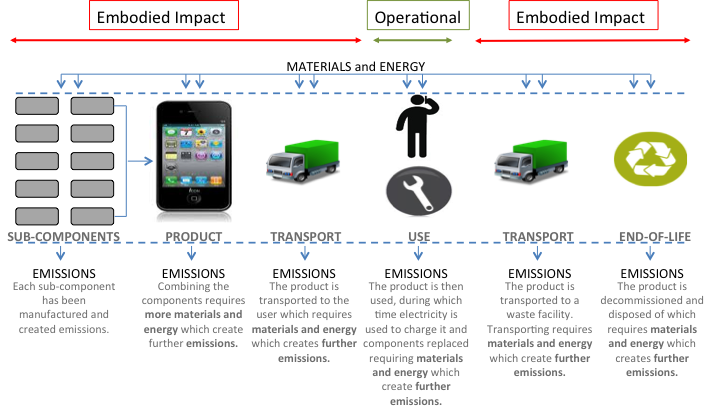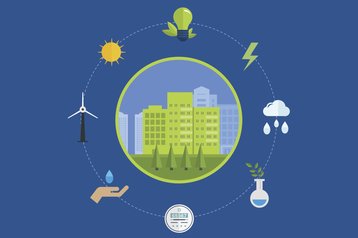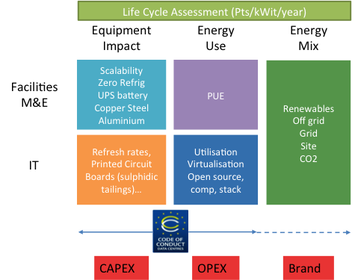This article sets out what is required for a truly sustainable data center, and how the industry can achieve this objective.
Sustainability has been defined as pertaining to environmental, social and economic longevity. Human life on earth is currently unsustainable; our consumption of natural resources has been calculated as exceeding those available, and it continues to rise. One impact of this is a high level of carbon emissions, which cause global warming.
The Intergovernmental Panel on Climate Change (IPCC) has set a target of limiting global warming to a two degree Celsius rise; this aims to mitigate the worst projected impacts of climate change such as global food and water shortages and associated migration / civil wars, although even a one degree rise is still likely to result in huge disruption to life on earth.
LCA is a methodology used to measure the environmental impact of a product or system over its entire life cycle, from raw material extraction and acquisition, through energy and material production and manufacturing, to use and end of life and final disposal. It considers several areas of protection (damage categories); the most commonly used ones are human health, ecosystem quality, resource depletion and climate change.
Most data centers measure their energy efficiency and electricity usage during operation, so the embodied impact of the production, transportation and disposal of the materials, components and systems used in the data center are not considered. The Green Grid’s data center maturity model requires for Level 5 (visionary, 5 years away) procurement so that ‘cradle-to-grave’ life cycle CO2 emissions are learned and controlled for all electrical and mechanical facilities.
The life cycle assessment of a UK data center study conducted by Whitehead and Shah (2015) concludes that the main contributors to data center total environmental impact are energy consumption, energy mix (electricity generation) and IT and mechanical and electrical (M&E) systems. Whitehead found that for a UK facility using free cooling with a three year server refresh rate, the operational impact is four times that of the embodied impact (PhD thesis). Of this environmental impact, the release of carcinogens is one of the largest contributors to the whole life cycle impact.
However, for an identical facility located in Sweden with reduced energy consumption (through IT consolidation and virtualisation) but an increased number of servers, the operational impact is half of that of the embodied impact. If the Swedish facility was located in the UK, the operational impact would be roughly equal to the embodied impact.
Lost watts
IT equipment is the largest energy consumer in most data centers and there are various ways in which the IT load can be reduced, principally through rationalisation, consolidation, virtualisation, hardware / software selection and enabling of energy saving features of IT equipment (details in The European Code of Conduct for Data center Energy Efficiency). Reducing IT energy consumption also has a cascade effect on M&E energy consumption.
PUE (Power Usage Effectiveness) is a metric commonly used to describe data center energy efficiency; it describes the ratio of total data center energy consumption to IT energy consumption. PUE indicates only how efficiently the energy consumed by M&E is used but does not give any detail on how effectively the IT energy is used. For most existing data centers, cooling is the largest energy consumer after the IT load, the largest component of which is from the refrigeration compressors. This is followed by computer room unit fans and then UPS losses.
New facilities which are designed for low energy consumption in many climates can achieve a PUE of around 1.2. This is achieved through minimising refrigeration requirements, by maximising the use of free cooling (economizer cycle), facilitated by increasing temperature set points amongst other things. In many global locations, zero refrigeration can be employed.
Good air management within the data hall is required in order to benefit from higher operating temperatures. This involves separation of hot and cold air streams so that cold air supplied to the room reaches IT equipment intakes with minimal temperature increase caused by recirculation.
Although the cooling system may be operating as designed and controlling to a return temperature of 22C (71.6F), there could still be hot spots within the space. Through analysis, air management improvements, set point increases, fan speed reduction and the installation of free cooling into existing cooling systems, significant operating cost reduction can be achieved in most data centers.
Green energy
Renewable energy sources produce significantly lower carbon emissions than fossil fuels. There are locations where cheap renewable energy is available and positive branding and corporate social responsibility are secondary benefits in these cases. ISO standard 30134-3 for sustainable IT, currently in development, includes a renewable energy factor as a key performance indicator for data centers. Purchasing off-site renewable energy is often more effective and practical than on-site generation, partly due to the capacity and corresponding area required for the generation plant, e.g. PV cells / wind turbines.
CUE (carbon usage effectiveness) is a measure of a data center’s in-use carbon emissions and is the product of its PUE and the source energy carbon intensity factor.
How it’s made
Whitehead and Shah’s research shows that the embodied impact of the IT equipment is double that of the M&E equipment. The impact of the IT equipment and M&E equipment is many hundreds of times that of the building itself due to the types and quantities of materials used. However, Building Environmental Assessment Methods (such as LEED and BREEAM), including those adapted for data center use, do not consider the embodied impact of IT and M&E equipment and hence are of limited use in helping operators to improve their environmental impact.
The main embodied impact from IT equipment stems from the disposal of metal refining waste products from the manufacture of IT components, in particular sulphidic tailings which contribute to human health issues. This impact can be reduced by: reducing the number of servers purchased, consolidation of services, hardware design, material selection, staged decommissioning, virtualisation, adoption of OpenStack and refresh rate policies.
High impact components used in M&E equipment include batteries, copper, aluminium and steel. In many cases, it may be possible to eliminate plant (along with materials and cost) at the design stage. Zero refrigeration systems do not have the associated electrical installation required to power them. This represents a capital and operational cost saving. Other considerations are: increased redundancy, over-specification and Open Compute.
Currently the significant wider environmental impact due to the embodied impact of IT equipment and M&E materials is still largely unmeasured; life cycle assessment is recommended as a sound methodology to evaluate this. Organizations with a strategic awareness of the landscape and trends will be better positioned to respond and capitalise on the business opportunities this presents, for example by increasing their brand value by demonstrating environmental leadership, reducing total cost of ownership and increasing profitability through innovation.
Ongoing innovation helps to drive the industry towards becoming truly sustainable, so that the benefits are not only environmental but also social and economic.
This feature was contributed by data center consultancy Operational Intelligence Ltd.



